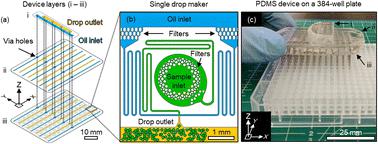Our official English website, www.x-mol.net, welcomes your feedback! (Note: you will need to create a separate account there.)
Rapid parallel generation of a fluorescently barcoded drop library from a microtiter plate using the plate-interfacing parallel encapsulation (PIPE) chip
Lab on a Chip ( IF 6.1 ) Pub Date : 2022-11-01 , DOI: 10.1039/d2lc00909a Geoffrey K Zath 1, 2 , Ralph A Sperling 3, 4 , Carter W Hoffman 1, 2, 5 , Dimitri A Bikos 1, 2 , Reha Abbasi 1, 2 , Adam R Abate 6 , David A Weitz 3, 7 , Connie B Chang 1, 2, 5
Lab on a Chip ( IF 6.1 ) Pub Date : 2022-11-01 , DOI: 10.1039/d2lc00909a Geoffrey K Zath 1, 2 , Ralph A Sperling 3, 4 , Carter W Hoffman 1, 2, 5 , Dimitri A Bikos 1, 2 , Reha Abbasi 1, 2 , Adam R Abate 6 , David A Weitz 3, 7 , Connie B Chang 1, 2, 5
Affiliation

|
In drop-based microfluidics, an aqueous sample is partitioned into drops using individual pump sources that drive water and oil into a drop-making device. Parallelization of drop-making devices is necessary to achieve high-throughput screening of multiple experimental conditions, especially in time-sensitive studies. Here, we present the plate-interfacing parallel encapsulation (PIPE) chip, a microfluidic chip designed to generate 50 to 90 μm diameter drops of up to 96 different conditions in parallel by interfacing individual drop makers with a standard 384-well microtiter plate. The PIPE chip is used to generate two types of optically barcoded drop libraries consisting of two-color fluorescent particle combinations: a library of 24 microbead barcodes and a library of 192 quantum dot barcodes. Barcoded combinations in the drop libraries are rapidly measured within a microfluidic device using fluorescence detection and distinct barcoded populations in the fluorescence drop data are identified using DBSCAN data clustering. Signal analysis reveals that particle size defines the source of dominant noise present in the fluorescence intensity distributions of the barcoded drop populations, arising from Poisson loading for microbeads and shot noise for quantum dots. A barcoded population from a drop library is isolated using fluorescence-activated drop sorting, enabling downstream analysis of drop contents. The PIPE chip can improve multiplexed high-throughput assays by enabling simultaneous encapsulation of barcoded samples stored in a microtiter plate and reducing sample preparation time.
中文翻译:

使用板接口并行封装 (PIPE) 芯片从微量滴定板快速并行生成荧光条形码液滴库
在基于液滴的微流体中,使用单独的泵源将水样分成液滴,将水和油驱动到液滴形成装置中。液滴制造装置的并行化对于实现多种实验条件的高通量筛选是必要的,特别是在时间敏感的研究中。在这里,我们展示了板接口平行封装 (PIPE) 芯片,这是一种微流控芯片,旨在通过将单个液滴制造器与标准 384 孔微量滴定板连接来并行生成多达 96 种不同条件的 50 至 90 μm 直径液滴。PIPE芯片用于生成两种类型的由双色荧光颗粒组合组成的光学条形码液滴库:24个微珠条形码的库和192个量子点条形码的库。使用荧光检测在微流体装置内快速测量液滴库中的条形码组合,并使用 DBSCAN 数据聚类来识别荧光液滴数据中的不同条形码群体。信号分析表明,颗粒尺寸定义了条形码液滴群荧光强度分布中存在的主要噪声源,这些噪声源自微珠的泊松载荷和量子点的散粒噪声。使用荧光激活液滴分选技术从液滴库中分离出带有条形码的群体,从而能够对液滴内容物进行下游分析。PIPE 芯片可以同时封装存储在微量滴定板中的条形码样品并减少样品制备时间,从而改进多重高通量测定。
更新日期:2022-11-01
中文翻译:

使用板接口并行封装 (PIPE) 芯片从微量滴定板快速并行生成荧光条形码液滴库
在基于液滴的微流体中,使用单独的泵源将水样分成液滴,将水和油驱动到液滴形成装置中。液滴制造装置的并行化对于实现多种实验条件的高通量筛选是必要的,特别是在时间敏感的研究中。在这里,我们展示了板接口平行封装 (PIPE) 芯片,这是一种微流控芯片,旨在通过将单个液滴制造器与标准 384 孔微量滴定板连接来并行生成多达 96 种不同条件的 50 至 90 μm 直径液滴。PIPE芯片用于生成两种类型的由双色荧光颗粒组合组成的光学条形码液滴库:24个微珠条形码的库和192个量子点条形码的库。使用荧光检测在微流体装置内快速测量液滴库中的条形码组合,并使用 DBSCAN 数据聚类来识别荧光液滴数据中的不同条形码群体。信号分析表明,颗粒尺寸定义了条形码液滴群荧光强度分布中存在的主要噪声源,这些噪声源自微珠的泊松载荷和量子点的散粒噪声。使用荧光激活液滴分选技术从液滴库中分离出带有条形码的群体,从而能够对液滴内容物进行下游分析。PIPE 芯片可以同时封装存储在微量滴定板中的条形码样品并减少样品制备时间,从而改进多重高通量测定。



























 京公网安备 11010802027423号
京公网安备 11010802027423号